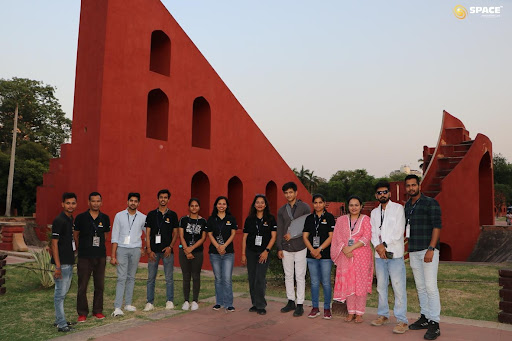Jantar Mantar is an observatory located in Delhi, India. It is one of several such observatories constructed by Maharaja Jai Singh II, the ruler of Jaipur, in the early 18th century. Jantar Mantar in Delhi is the largest among the five observatories built by Jai Singh II. It features various instruments, including the Samrat Yantra (the world’s largest sundial), the Jayaprakash Yantra (a hemisphere used for observing the positions of celestial bodies), the Misra Yantra (a combination of five instruments), and more. The observatory consists of a collection of architectural instruments used to measure time, track celestial bodies, and study astronomical phenomena. So, the location has its own astronomical importance in itself.
Space India group has formed a collaboration with the esteemed National Science Centre National Science Centre and Nehru Planetarium in Delhi for a remarkable event known as “Astro Night Sky Tourism.” This captivating event takes place on a monthly basis at various enchanting locations.
Astro Night Sky Tourism has swiftly emerged as a beloved monthly affair among the residents of Delhi, captivating the hearts of both astronomy enthusiasts and the general public. The night of May 5th and 6th witnessed a remarkable gathering of approximately 4500+ individuals, brimming with anticipation to explore the celestial wonders up-close. The event ignited an equal level of enthusiasm among the dedicated educators and supportive staff members who were present, eagerly assisting visitors with their telescopic observations.
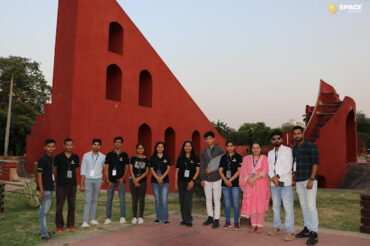
From engaging activities like crafting Solar System models to creating captivating Comets, students and other attendees, embarked on a journey of discovery. They delved into the fascinating realm of our celestial neighborhood, astounded by the enlightening size comparisons between the radiant Sun and the majestic planets that reside within our solar system. Moreover, the exploration of the various components comprising a comet left the audience spellbound, as they unveiled the enigmatic secrets concealed within the vast expanse of our galaxy.
The event showcased a remarkable fusion of cutting-edge equipment and advanced technology, where knowledgeable educators imparted a profound understanding of modern advancements in Astronomy and sky observation. The audience was enthralled as they were introduced to revolutionary software like Stellarium, which opened their eyes to the wonders of the cosmos. In an enlightening activity focused on the weight of objects on different planets, attendees gained a profound understanding of the respective gravity exerted by different planets and the moon. This engaging exercise provided students with a valuable opportunity to grasp the concept of gravity, and comprehending the intrinsic disparities between mass and weight.
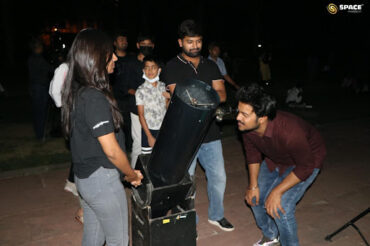
To offer an immersive experience, a diverse range of telescopes, each possessing unique capabilities and magnifications, was employed, allowing the audience to witness celestial marvels first-hand. Participants were transported to different worlds as they gazed through these telescopes, marveling at the varying splendors of the cosmos. The ethereal brilliance of Venus, radiating a mesmerizing aura, captivated the audience and bestowed upon them a visual delight. The fortuitous presence of Venus in its gibbous phase allowed for a remarkable and accessible observation, leaving the onlookers in a state of awe. The naked-eye view of Venus, followed by the telescopic observation, served as an enlightening experience, instilling a deep appreciation for the significance of telescopes in the field of Astronomy.
The Moon, our closest celestial companion, graced us with a mesmerizing penumbral eclipse on the enchanting night of May 5th. The mere thought of witnessing the moon’s majestic craters stirred such fervent excitement among the people that they eagerly formed a serpentine queue, eagerly awaiting their turn. As the moon began its celestial dance, a collective gasp of awe swept through the crowd, adorning their faces with expressions of pure wonder. Departing from this celestial spectacle, the eager observers were inspired and carrying with them a renewed determination to experience the celestial ballet of a lunar eclipse.
Unfortunately, the night sky’s luminosity was marred by pollution, making it challenging for observers to witness the vibrant red sphere of common interest—Mars. However, the indomitable Space’s Dobsonian telescope came to the rescue, enabling a glimpse of Mars against all odds. The frequent mentions of Mars in the news and its status as a focal point for space agencies had fuelled a keen interest among people, intensifying their desire to observe the red planet. The quest to acquaint themselves with Mars considered a potential second home for humanity, was a major driving force behind the palpable enthusiasm radiating from the attendees. By directly witnessing the celestial wonders of Venus and Mars, individuals gained newfound confidence in the scientific breakthroughs of space science. This experience served as a realization of Space India’s mission to foster a scientific temperament among the general populace, thereby fulfilling their visionary goals.
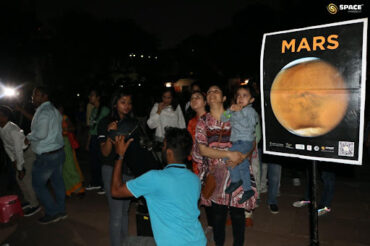
Amitosh, a woman in her mid-age, exuded such enthusiasm for the event that she arrived even before its scheduled start. Her inquisitive nature drove her to ask numerous questions about the majestic Sun dial of Jantar Mantar, the intricate workings of direction systems, the concept of local noon, and the mesmerizing phenomena of sunspots. Inspired by her unwavering dedication to expanding her knowledge of space and space science, I felt compelled to share with her every intricate detail of astronomy that I could offer.
Later, our dedicated team enlightened her further about the iAstronomer program, an offering by Space India that caters to individuals of all age groups, providing a comprehensive learning experience in astronomy, coupled with a multitude of additional benefits. Amitosh’s unwavering presence lasted until the event’s conclusion, where she had the privilege of experiencing the captivating night sky through the lens of a telescope. Upon her departure, she expressed her utmost admiration for the event, leaving us with a heartwarming smile of satisfaction.
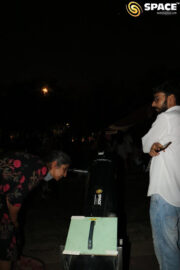
Another extraordinary story unfolded with Kisna Garg, a sixth-grade student and a member of Space’s Astronomy club. Kisna had the rare opportunity to capture a photograph of Venus using one of our telescopes. This small act of accomplishment fuelled a profound sense of pride within the young student. Such stories of personal triumphs serve as a driving force for our educators, inspiring them to go the extra mile in their efforts. Before I conclude, I cannot resist sharing the picture taken by Kisna Garg. While it may not be the most technically perfect image you have ever seen, I am confident that it will evoke a deep emotional connection within you, symbolizing the beauty and wonder of our celestial surroundings.
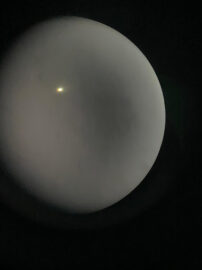
The enchanting allure of Astro Night Sky Tourism has captured the interest of numerous media outlets. Among them, the esteemed Aaj Tak group (GNT), known for its exceptional coverage, approached the event to showcase its wonders to the world. They conducted interviews with enthusiastic attendees, passionate students, and knowledgeable educators from the Space group. The extensive media coverage bestowed upon astronomy through these electronic media platforms has truly fulfilled one of the cherished aspirations of the Space groups.

The ensuing discussions between the observers and educators added an enriching dimension to the event. Participants eagerly sought technical details about the telescopes used, engaging in insightful exchanges that further fuelled their curiosity. The observers expressed their admiration for Astro Night Sky Tourism, underscoring the event’s immense value.
Stories and feedback like these are precious medals worth cherishing. The Space group aspires to organize similar outreach events, aiming to ignite a passion for science and astronomy among the general populace.

